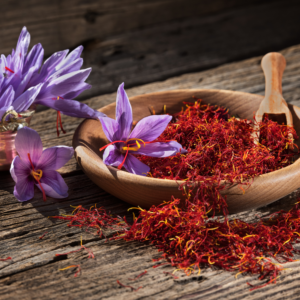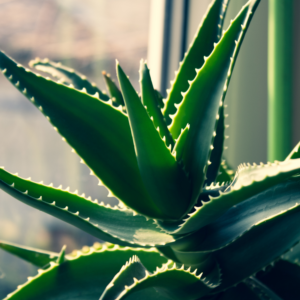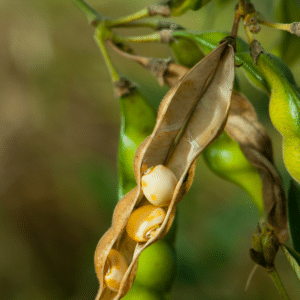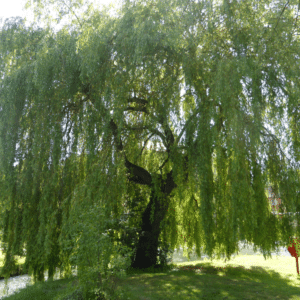written by: Allison Goins, Ph.D. | Published on December 28th at 6:00 am
Hyperpigmentation is one of the most common skin concerns, but nature may hold the solution. Botanical tyrosinase inhibitors, derived from plants, are an alternate way to target melanin production and reduce dark spots. These natural ingredients are rich in antioxidants and bioactive compounds that work to brighten the skin. Many of these botanical tyrosinase inhibitors naturally contain popular hyperpigmentation ingredients like Vitamin C, galabridin, and arbutin. But does the science support their brightening benefits? In this article, we’ll explore the top botanical tyrosinase inhibitors in skincare, how they work, and if they compare to their synthetic alternatives.
What Are Botanical Tyrosinase Inhibitors?
Tyrosinase inhibitors are ingredients that block or reduce tyrosinase activity, an enzyme responsible for melanin production. Botanical tyrosinase inhibitors, in particular, come from natural plant sources. These plants often contain the same molecules that synthetic brightening serums use. Whether the source is botanical or synthetic, tyrosinase inhibitors reduce excess melanin production and usually include antioxidants, vitamins, and soothing compounds that benefit the skin overall.
The Top Botanical Tyrosinase Inhibitors in Skincare
1. Licorice Root Extract (Glabridin)

Licorice root, Glycyrrhiza glabra is one of the most well-studied botanical tyrosinase inhibitors, with studies dating back to the 1990s. It contains glabridin, which reduces pigmentation and brightens the skin by directly inhibiting tyrosinase activity. Most of the clinical studies show a product with 2-1% licorice root extract was able to help with brightening.
Related Post: Unveiling Nature’s Hyperpigmentation Super Ingredient: Licorice Root Benefits for Skin
2. Mulberry Extract (Arbutin)

Mulberry, Morus nigra extract, derived from the leaves and roots of the mulberry tree, is a natural source of antioxidants and tyrosinase inhibitors. Arbutin is a common tyrosinase inhibitor that is present in mulberry extract. In clinical studies, topical concentration was needed from 4-75% to see a brightening effect. Those studies showed that the mulberry extract reduced pigmentation and even skin tone. However, irritation was reported in one study.
3. Bearberry Extract (Arbutin)

Bearberry, Arctostaphylos rubra extract is another naturally occurring source of arbutin. Arbutin’s synthetic form is particularly effective at fading dark spots and reducing freckles. Although barberry extract contains arbutin, much less evidence supports its brightening abilities. I found only one study that used barberry extract with other brightening ingredients. Of all of the botanical tyrosinase inhibitors on this list, this one is the least backed by science.
4. Green Tea Extract (EGCG)

Green tea, Camellia sinensis extract, mainly its active compound EGCG (epigallocatechin gallate), is a powerful antioxidant. However, there is no clinical evidence that it can help brighten skin. Some studies show that concentrations between 2–6% green tea extract may aid in skin elasticity and hydration. However, no clinical evidence shows it can prevent the formation of hyperpigmentation the same way other tyrosinase inhibitors do. This does not mean it cannot be helpful in your journey fighting hyperpigmentation. Green tea extract is full of antioxidants. Antioxidants help with hyperpigmentation by preventing UV rays from triggering the biological process of melanin formation.
Related Post: The Ultimate Guide to Natural Antioxidants for Skin
5. Turmeric (Curcumin)

Turmeric, Curcuma longa is very popular in Ayurvedic medicine. Ayurveda is a traditional Indian medical practice. The cultural popularity of turmeric has translated to its use in mainstream skincare for anti-inflammatory and skin-brightening properties. Curcumin, its active compound, inhibits tyrosinase activity and reduces oxidative damage that contributes to hyperpigmentation. But that does not necessarily mean turmeric extract really helps with hyperpigmentation. Here’s what science says.
Studies suggest that turmeric, or its active compound curcumin, can improve hyperpigmentation when applied to the skin. A study published in the Journal of the American Academy of Dermatology found that a moisturizing cream with turmeric extract reduced facial dark spots and improved skin texture in a couple of weeks.
Another study in the Journal of Integrative Dermatology showed that products combining turmeric with other well-known actives like niacinamide could reduce hyperpigmentation by about 14% after 8 weeks. This suggests it can lighten dark spots but may take time to show results. While these results are promising, these are only two studies. The research on turmeric for hyperpigmentation is still very limited. Most studies are small, and the effects are definitely not as strong as synthetic treatments.
6. Saffron Extract (Crocin)

Saffron, Crocus sativus, is known for its vibrant yellow color and is one of the world’s most expensive spices. So, it is not surprising, particularly in the luxury skincare space, that some brands have looked to incorporate it as an active ingredient. Many brands tout it as a skin-brightening ingredient and potential botanical tyrosinase inhibitor.
Saffron contains carotenoids like crocin and crocetin, which have antioxidant and anti-inflammatory properties. These compounds may help reduce hyperpigmentation by blocking tyrosinase. A review published in the Jurnal Kedokteran Diponegoro highlighted saffron’s potential for addressing skin discoloration, including melasma. However, most of the information came from lab studies. The clinical studies on saffron as a topical skincare ingredient for hyperpigmentation are still limited. Most of the evidence comes from small-scale or theoretical studies. Larger, more focused clinical trials are needed to say saffron is an effective ingredient in treating hyperpigmentation.
For now, the science says saffron as an active skincare ingredient is more about the marketing and luxurious aesthetic than its ability to treat hyperpigmentation.
7. Aloe Vera Extract (Aloesin)

Aloe vera is most widely known in skin care for its hydrating and soothing properties. There is also some discussion in the skincare community about its ability to fight hyperpigmentation. Aloe vera also contains aloesin. There is evidence aloesin may be a natural tyrosinase inhibitor. Due to the irritating effects of many skincare actives, it is attractive and active for treating pigmentation while soothing and hydrating the skin. But what does science say?
Aloe vera contains aloin and aloesin, which can lighten dark spots by reducing melanin production. Lab studies show that aloesin can block tyrosinase, an enzyme that helps create melanin. A study in the Journal of Cosmetic Dermatology found that in a petri dish, aloesin can reduce pigmentation by slowing down melanin production. Another study tested aloe vera on people with melasma, a common type of hyperpigmentation. Participants used a cream with aloe vera extract for 12 weeks, and the treated areas became noticeably lighter compared to untreated areas. Fermented aloe vera extracts might be even more effective. Research in Fermentation found that fermentation boosts aloe vera’s antioxidant levels and enhances its ability to lighten pigmentation.
This is another botanical tyrosinase inhibitor that has some promising lab studies, but more large-scale clinical studies are needed to confirm aloe vera’s effectiveness in treating hyperpigmentation.
8. Soy Isoflavones

Soybean, Glycine max extract are rich in isoflavones. Soy isoflavones, such as genistein and daidzein, are theorized to reduce hyperpigmentation by blocking the transfer of melanin from melanocytes to other skin cells. But do they work? Let’s look at the science.
A study in the Journal of the American Academy of Dermatology tested a lotion with soy proteins on people with dark spots. After 12 weeks of daily use, participants saw fewer dark spots and brighter skin overall. Another review in the Journal of Clinical Medicine found that soy-based products, both oral and topical, improved skin health by increasing collagen and elasticity while reducing pigmentation.
Soy isoflavones are also antioxidants, which help protect skin from damage that can worsen hyperpigmentation. These studies show that soy-based skincare has promise as a botanical tyrosinase inhibitor.
9. Papaya Extract (Papain)

Papaya, Carica papaya is often used in skincare because of its natural enzymes and vitamins. This makes it an excellent marketing tool, but is it effective for hyperpigmentation? Here’s what science says.
Papaya contains an enzyme called papain, which helps exfoliate the skin by removing dead skin cells. This exfoliation can speed up skin cell turnover, making dark spots less noticeable over time. Papaya is also rich in antioxidants like vitamin C and flavonoids, which can reduce melanin production and protect the skin from oxidative stress, a factor that can worsen hyperpigmentation.
A review in the International Journal of Botany Studies highlights these skin-friendly properties of papaya, noting its potential to brighten the skin and improve texture. While these features suggest papaya can help with hyperpigmentation, there are currently no large-scale clinical studies specifically proving its effectiveness for this condition. So, while papaya’s exfoliating and antioxidant properties might support brighter, more even-toned skin, it’s not yet a fully science-backed solution for hyperpigmentation. More focused research is needed to confirm its benefits and determine the best way to use it.
10. White Willow Bark (Salicin)

White willow bark, Salix alba, is a natural source of salicin. It is often used in skincare because it contains salicin, a compound similar to aspirin, a well-known anti-inflammatory. But does this effect translate to white willow bark extract, and is it an effective skincare active for hyperpigmentation? Here’s what we know from the scientific studies.
Inflammation can trigger excess melanin production, which causes dark spots, so reducing inflammation may help prevent hyperpigmentation from getting worse. White willow bark also helps exfoliate the skin by removing dead skin cells. This gentle exfoliation can brighten the skin and might fade dark spots over time. While these properties are promising, there aren’t many direct scientific studies on white willow bark specifically for hyperpigmentation. Its effects are more commonly linked to its ability to soothe the skin and improve overall skin texture. The exfoliation it provides is mild compared to stronger ingredients like salicylic acid derived from willow bark.
In conclusion, white willow bark may support brighter and healthier-looking skin, but it’s not a proven solution for hyperpigmentation on its own. It’s best used alongside other treatments that are specifically designed to reduce dark spots.
11. Chamomile Extract (Apigenin)

Chamomile extract, Matricaria chamomilla plant, is widely used in skincare for its calming and anti-inflammatory effects. But does it work for hyperpigmentation? Let’s explore.
Chamomile contains compounds like apigenin, which has been shown in laboratory studies to block tyrosinase, an enzyme involved in melanin production. Since excess melanin causes dark spots, this suggests chamomile might help lighten hyperpigmentation. Its antioxidants also protect the skin from damage that can worsen discoloration. While these properties sound promising, little direct research shows that chamomile extract reduces hyperpigmentation. Most studies focus on its ability to soothe skin and improve conditions like eczema or irritation, which could indirectly improve skin tone but does not make it a tyrosinase inhibitor.
In conclusion, chamomile extract may have the potential for managing hyperpigmentation thanks to its anti-inflammatory and antioxidant effects. However, more scientific studies are needed to confirm if it’s an effective botanical tyrosinase inhibitor to treat hyperpigmentation.
Final Thoughts on Botanical Tyrosinase Inhibitors
Botanical tyrosinase inhibitors are nature’s way of brightening skin and reducing hyperpigmentation. From the calming properties of chamomile to the brightening effects of licorice root and aloe vera, these plant-based ingredients can offer an approach to achieving an even complexion.
Most of these ingredients are widely used in traditional medicine forms. And the lack of scientific literature does not diminish their historical and cultural importance. More research is needed to form a science-based point of view on the effects of these botanical tyrosinase inhibitors. Today, the synthetic forms of these ingredients are more supported by science, but that does not mean as more studies are done and the scientific landscape evolves, they cannot be on par with their synthetic counterparts.
However, if you want to explore botanical ingredients in your skincare routine, many are still worth trying as long as you have realistic expectations and use them consistently. Incorporate these natural wonders into your routine, and pair them with consistent sun protection for long-lasting results.
